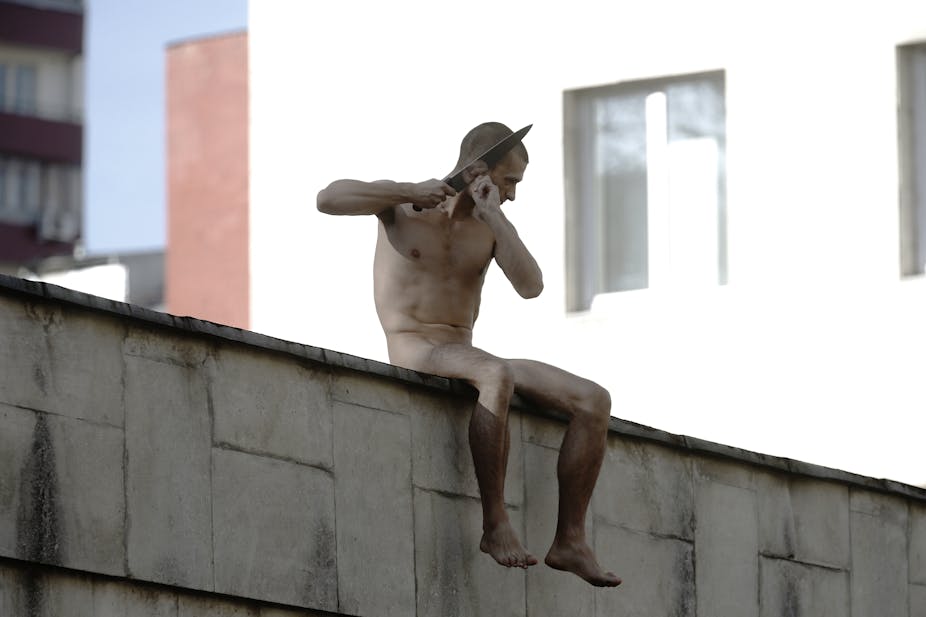On October 19, Russian artist Petr Pavlensky sat on a wall outside a mental institution in Moscow and cut off his earlobe. He did so in protest of the continued use of psychiatric treatment on dissidents in Russia. One year earlier, the same artist nailed his scrotum to a cobblestone in Red Square – a call to action to his fellow citizens to not remain passive in the face of corruption and abuses of authority.
Pavlensky is far from the only cultural figure to make international headlines. The punk feminist performance group Pussy Riot have hardly been out of the papers since the August 17 2012 ruling that three members were to be jailed jailed for two years for hooliganism for their performance in the Cathedral of Christ the Saviour in Moscow, which voiced objection to the open support of Putin by the Russian Orthodox Church.

Russia has seen a surge in such performance art actions while individual liberties have been rapidly diminishing. Performance art has often been used in ways that resemble protest and so it’s unsurprising that it is often perceived as hooliganism. But these very dramatic and public forms of art are actually connected to a long line of performance traditions in Russia that date back to the revolutionary era.
A longer tradition
Performance has long been a part of Western art and culture, from Greek dramas and Medieval pageant plays to Renaissance festivals. But “performance art”, where visual artists use their bodies to create works of art, is largely a 20th century phenomenon. The Dada and Futurist artists from the early 20th century used performance and action to play with audience expectations, involve the viewer in the artwork, and even provoke a reaction. The Italian Futurists even tried to annoy their audiences – putting glue or itching powder on the theatre seats on the night of their performances. For them, any reaction was a good reaction, because it meant that people were actively thinking, rather than passively living their lives. But it wasn’t until the 1960s that these avant-garde traditions were rekindled, and performance took its place among painting and sculpture as an art form in its own right.

Russia has its own tradition of performance art. The Russian Futurists, who conceived of themselves as separate and distinct from the brand of Futurism proliferated by the Italians, walked through the streets of St. Petersburg with unusual markings and algebraic symbols painted on their faces. This is perhaps not so shocking for viewers nowadays, but definitely revolutionary in pre-revolutionary Russia. The Futurists, in general, wanted to shake up the status quo, awaken people from the stupor of their regimented and monotonous everyday lives, to look at things anew. They did this by using shock to thwart peoples’ expectations and get them to pay attention to the world around them.
Beginning in the 1930s, all artistic activity in the Soviet Union came under state control, and the experimental work begun by the likes of the Russian Futurists was quashed. Following the Thaw and the death of Stalin in 1953, artists began to experiment once again, although this activity took place largely underground, without the official sanction of the state.
Performance was one of the main ways that artists could experiment freely. One group, Collective Actions, staged performances in the countryside. These comprised not only the action (they preferred this term to performance) that took place, but the journey out to the location and the discussion that ensued. Many believe that the work of these nonconformist artists contributed to the loosening of restrictions and increase of freedoms of self-expression that eventually led to the end of the USSR.

Shock
The vibrant performance art of contemporary Russia is often misunderstood. The decision to jail two members of Pussy Riot for hooliganism not only reflected what the courts and current political regime thought of them, but also much public opinion. There are those that support the right of Pussy Riot, among other artists and citizens, to freely express themselves, but the crackdowns on the right to peacefully demonstrate and publicly protest in Russia have not spurred a reactive revolution, but rather pushed many human rights advocates further underground.
In this environment, the need for shocking and jarring performances becomes clear – this is not just shock for its own sake. Rather, it is geared toward compelling a largely silent majority to act and react. Pavlensky said that he nailed himself to Red Square to inspire them to do something – not to nail their body parts to the ground, but to find “their own chosen form” of action.
If the actions by Pussy Riot and Pavlensky seem to be extreme, they are in fact reacting to the extreme situation they find themselves in, as both artists and individuals. But it should also be remembered that their actions are part of a long line of performance traditions aimed at motivating the masses and creating social and political change in Russia, for the benefit of all citizens.

